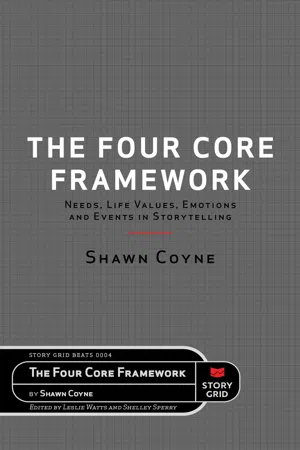
- English
- ePUB (mobile friendly)
- Available on iOS & Android
The Four Core Fiction
About This Book
What's at the core of every great story that leads readers to rush breathlessly to the end and then share it with all their friends?
At Story Grid, we believe great stories are built of four essential elements: Core Needs, Core Life Values, Core Emotions, and Core Events. Whether you're writing an action adventure, a mystery, or a love story, these are the elements that spark the emotional connection and catharsis readers are looking for.
Assembled into a Four Core Framework, the right need, life value, emotion, and event become the blueprint for a story that will satisfy readers and bring them back for more.
In The Four Core Framework, Story Grid founder Shawn Coyne distills 30 years of experience in publishing into a compact guide for writers who want their novels, screenplays, and nonfiction to resonate and captivate. He dissects twelve kinds of stories and explains how to create the the ideal framework for each, including:
- A Core Need that will make your story an all-night read;
- A Core Life Value that will guide your characters' evolution;
- A Core Emotion that will enthrall your audience;
- and A Core Event that will provide the final payoff readers are waiting for.
In The Four Core Framework, you'll learn to keep readers turning the pages and rushing to recommend your stories. Join Shawn to get down to the core of it all.
Frequently asked questions
Information
CONTENT GENRES IN THE STORY GRID UNIVERSE
UNIFYING THREADS IN THE STORY GRID UNIVERSE
WHAT READERS WANT AND NEED
- The Core Need (survival or esteem, for example)
- The Core Life Values (a range from life to death or impotence to power, for example)
- The Core Emotion (excitement or admiration, for example)
- The Core Event (a scene demonstrating proof of love or a showdown between the protagonist and antagonist, for example)
Table of contents
- Cover
- Contents
- THE TRUTH IS
- WELCOME TO THE STORY GRID UNIVERSE
- Title Page
- Copyright
- Dedication
- About This Book
- 1. CONTENT GENRES IN THE STORY GRID UNIVERSE
- 2. UNIFYING THREADS IN THE STORY GRID UNIVERSE
- 3. WHAT READERS WANT AND NEED
- 4. ACTION STORY
- 5. WAR STORY
- 6. HORROR STORY
- 7. CRIME STORY
- 8. THRILLER STORY
- 9. WESTERN STORY
- 10. LOVE STORY
- 11. PERFORMANCE STORY
- 12. SOCIETY STORY
- 13. STATUS STORY
- 14. MORALITY STORY
- 15. WORLDVIEW STORY
- THE FOUR CORE CONCLUSION
- About the Author